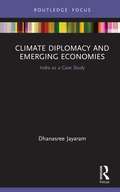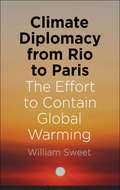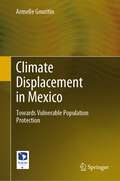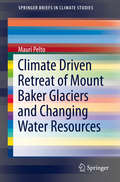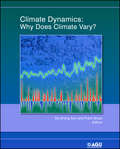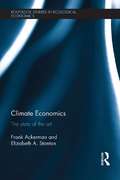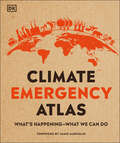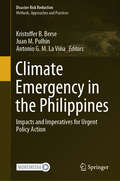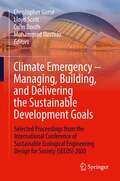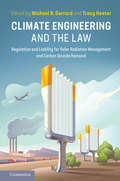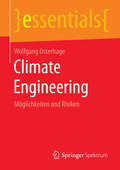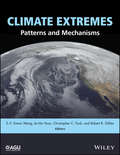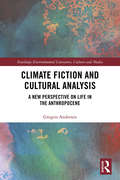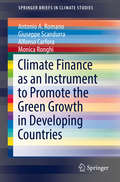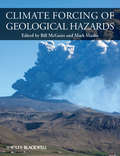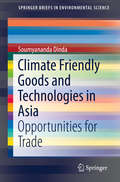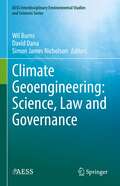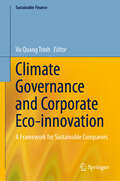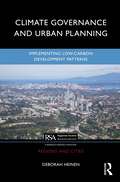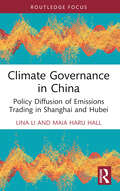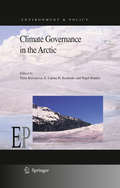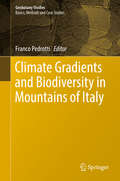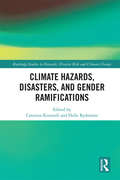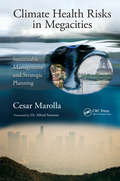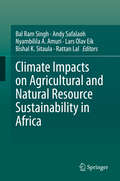- Table View
- List View
Climate Diplomacy and Emerging Economies: India as a Case Study (Routledge Focus on Environment and Sustainability)
by Dhanasree JayaramThis book analyses the role of the BASIC countries – Brazil, South Africa, India and China – in the international climate order. Climate Diplomacy and Emerging Economies explores the collective and individual positions of these countries towards climate diplomacy, focusing in particular on the time period between the 2009 and 2019 climate summits in Copenhagen and Madrid. Dhanasree Jayaram examines the key drivers behind their climate-related policies (both domestic and international) and explores the contributory role of ideational and material factors (and the interaction between them) in shaping the climate diplomacy agenda at multilateral, bilateral and other levels. Digging deeper into the case study of India, Jayaram studies the shifts in its climate diplomacy by looking into the ways in which climate change is framed and analyses the variations in perceptions of the causes of climate change, the solutions to it, the motivations for setting climate action goals, and the methods to achieve the goals. This book will be of great interest to students and scholars of climate change, environmental policy and politics and IR more broadly.
Climate Diplomacy from Rio to Paris: The Effort to Contain Global Warming
by William SweetThe essential primer for understanding climate diplomacy, describing both the major players and the path to progress, from the 1992 Rio Summit to the 2015 Paris Climate Conference Climate Diplomacy from Rio to Paris is the first accessible overview of climate diplomacy in its first quarter century. The author, who has reported on energy and climate for two decades, provides readers with a nuanced account of the major players and their interests--from the United States, the European Union, and China to environmental organizations, the United Nations, and the Vatican--and analyzes the outcomes of the major climate conferences at Rio, Kyoto, Copenhagen, and Paris.
Climate Displacement in Mexico: Towards Vulnerable Population Protection
by Armelle GouritinThis book presents the updated results of an investigation carried out in 2019. The National Autonomous University of Mexico’s (UNAM) Climate Change Research Program (PINCC), funded the research coordinated by Armelle Gouritin. The research aims to answer the following questions: Does the Mexican legal framework and public policies address forced internal climate mobility? If not, what could be the elements of a legal framework and public policies to address the phenomenon? As the phenomenon was approached it was clear that it was extremely complex and consisted of numerous tensions that would lead to other questions throughout the research process.Climate forced internal displacement is projected as a huge-scale phenomenon in Mexico. Against this background, the book provides the first critical diagnosis of the current politico-legal Mexican framework and finds it to be lagging behind in terms of prevention and attention. The book analyses the three-level Mexican governance (federal, state and local levels), and identifies serious loopholes according to a rights-based approach that particularly focuses on women, indigenous peoples, and persons and communities with scarce economic resources. The results provide information on up-coming legislative and political processes and provide benchmarks that can be applied in other case-studies, including other national frameworks’ critical analysis.
Climate Driven Retreat of Mount Baker Glaciers and Changing Water Resources (SpringerBriefs in Climate Studies)
by Mauri PeltoThis book presents the impact of climate change on Mount Baker glaciers, USA, and the rivers surrounding them. Glaciers are natural reservoirs that yield their resource primarily on warm dry summer days when other sources are at their lowest yield. This natural tempering of drought conditions will be reduced as they retreat. Mount Baker, a volcano in the Cascades of Washington, is currently host to 12 principal glaciers with an area of 36. 8 km2. The glaciers yield 125 million cubic meters of water each summer that is a resource for salmon, irrigation and hydropower to the Nooksack River and Baker River watersheds. Recent rapid retreat of all 22 glaciers is altering the runoff from the glaciers, impacting both the discharge and temperature of the Nooksack and Baker River. Over the last 30 years we have spent 270 nights camped on the mountain conducting 10,500 observations of snow depth and melt rate on Mount Baker. This data combined with observations of terminus change, area change and glacier runoff over the same 30 years allow an unusually comprehensive story to be told of the effects of climate change to Mount Baker Glaciers and the rivers that drain them.
Climate Dynamics: Why Does Climate Vary
by De-Zheng Sun Frank BryanPublished by the American Geophysical Union as part of the Geophysical Monograph Series, Volume 189.Climate Dynamics: Why Does Climate Vary? presents the major climate phenomena within the climate system to underscore the potency of dynamics in giving rise to climate change and variability. These phenomena include deep convection over the Indo-Pacific warm pool and its planetary-scale organization: the Madden-Julian Oscillation, the monsoons, the El Niño-Southern Oscillation, the Pacific Decadal Oscillation, and the low-frequency variability of extratropical circulations. The volume also has a chapter focusing on the discussion of the causes of the recent melting of Arctic sea ice and a chapter devoted to the discussion of the causes of recent changes in the frequency and intensity of tropical cyclones. On each topic, the basic material of climate dynamics is covered to aid the understanding of the forefront research, making the volume accessible to a broad spectrum of readers.The volume highlights includeDiabatic and nonlinear aspects of the El Niño-Southern OscillationCauses of sea ice melting in the ArcticImpact of global warming on tropical cyclone activityOrigins of the Pacific Decadal OscillationCauses of climate variability of Asian monsoonsThe volume will be of particular interest to graduate students and young researchers in atmospheric and oceanic sciences and related disciplines such as geology and geography. The book will also be a good read for those who have a more general interest in the Earth's climate and why it varies.
Climate Economics: The State of the Art (Routledge Studies in Ecological Economics)
by Frank Ackerman Elizabeth A. StantonClimate science paints a bleak picture: The continued growth of greenhouse gas emissions is increasingly likely to cause irreversible and catastrophic effects. Urgent action is needed to prepare for the initial rounds of climatic change, which are already unstoppable. While the opportunity to avert all climate damage has now passed, well-designed mitigation and adaptation policies, if adopted quickly, could still greatly reduce the likelihood of the most tragic and far-reaching impacts of climate change. Climate economics is the bridge between science and policy, translating scientific predictions about physical systems into projections about economic growth and human welfare that decision makers can most readily use but it has too often consisted of an overly technical, academic approach to the problem. Getting climate economics right is not about publishing the cleverest article of the year but rather about helping solve the dilemma of the century. The tasks ahead are daunting, and failure, unfortunately, is quite possible. Better approaches to climate economics will allow economists to be part of the solution rather than part of the problem. This book analyzes potential paths for improvement.
Climate Emergency Atlas (DK Where on Earth? Atlases)
by Dan HookeOur house is on fire - it's time to wake up to the climate crisis facing planet Earth before it's too late.This unique graphic atlas tells you everything you need to know about climate change and what we can do to turn things around. Which countries generate the highest CO2 emissions? Which coastal cities are most vulnerable to rising sea levels? What will the polar ice caps look like in 10 years' time? Which countries have successfully harnessed renewable energy sources?Includes facts and figures and more than 30 dynamic maps, Climate Emergency Atlas is clear and easy to understand, making it the perfect reference guide for all young climate activists.
Climate Emergency in the Philippines: Impacts and Imperatives for Urgent Policy Action (Disaster Risk Reduction)
by Juan M. Pulhin Kristoffer B. Berse Antonio G. M. La ViñaThis book provides a snapshot of the manifestations of the climate emergency in the Philippines from a wide array of disciplines including physical sciences, social sciences, arts and humanities, management, and law. Researchers and faculties at the University of the Philippines contributed to this compilation, where each chapter provides policymakers and the public a clear picture of why climate change must be confronted with a sense of urgency and near-desperation.Divided into three main parts, the first one zeroes in on climate-vulnerable sectors such as water, food and agriculture, health, and coastal communities in the Philippines to introduce readers to the current pressing impacts of the climate emergency. The second part presents case studies of local experiences from the country’s three island regions, namely, Luzon, Visayas, and Mindanao, and it situates the readers in different environments and contexts. The third part features transdisciplinary responses to the climate emergency, including salient challenges in relation to planning, financing, communication, and education. The concluding chapter highlights eight areas for action to tackle the climate emergency. Each chapter comes with an overview and a Summary for Policymakers, which provides clear guidance for action to be taken by both local and national policymakers.
Climate Emergency – Managing, Building , and Delivering the Sustainable Development Goals: Selected Proceedings from the International Conference of Sustainable Ecological Engineering Design for Society (SEEDS) 2020
by Mohammad Dastbaz Christopher Gorse Colin Booth Lloyd ScottThrough research and proven practice, the aim of the International Conference of Sustainable Ecological Engineering Design for Society (SEEDS) is to foster ideas on how to reduce negative impacts on the environment while providing for the health and well-being of society. The professions and fields of research required to ensure buildings meet user demands and provide healthy enclosures are many and diverse. The SEEDS conference addresses the interdependence of people, the built and natural environments, and recognizes the interdisciplinary and international themes necessary to assemble the knowledge required for positive change.
Climate Engineering and the Law: Regulation And Liability For Solar Radiation Management And Carbon Dioxide Removal
by Michael B. Gerrard Tracy HesterClimate change is increasingly recognized as a global threat, and is already contributing to record-breaking hurricanes and heat waves. To prevent the worst impacts, attention is now turning to climate engineering - the intentional large-scale modification of the environment to reduce the impact of climate change. The two principal methods involve removing some carbon dioxide from the atmosphere (which could consume huge amounts of land and money, and take a long period of time), and reducing the amount of solar radiation reaching the earth's surface, perhaps by spraying aerosols into the upper atmosphere from airplanes (which could be done quickly but is risky and highly controversial). <P><P>This is the first book to focus on the legal aspects of these technologies: what government approvals would be needed; how liability would be assessed and compensation provided if something goes wrong; and how a governance system could be structured and agreed internationally.<P> In view of the disastrous Hurricanes Harvey, Irene and Maria, and the Trump administration's abandonment of action on climate change, increasing attention is going to climate engineering as a way to avoid the worst impacts of climate change.<P> Gives an overview of the relevant laws with detailed legal analysis Makes recommendations for what a governance system for climate engineering should entail.<P> Written and edited by established environmental law experts.
Climate Engineering: Möglichkeiten und Risiken (essentials)
by Wolfgang OsterhageUnter der Prämisse, dass ein Klimawandel stattfindet, arbeitet Wolfgang Osterhage eine Problemstellung heraus, die zu Lösungsvorschlägen im Rahmen des Climate Engineering führt, mit welchen das Klima pro-aktiv beeinflusst werden kann. Der Autor stellt die hierfür erforderlichen technischen Maßnahmen vor. In die Bewertung von Risiken fließen thermodynamische und chaostheoretische Überlegungen ein, die zu einer kritischen Beurteilung führen. Weitere Bewertungskriterien ergeben sich schließlich aus ethischen Grundsatzüberlegungen.
Climate Extremes: Patterns and Mechanisms
by Christopher C. Funk Jin-Ho Yoon Robert R. Gillies S.-Y. Simon WangAlthough we are seeing more weather and climate extremes, individual extreme events are very diverse and generalization of trends is difficult. For example, mid-latitude and subtropical climate extremes such as heat waves, hurricanes and droughts have increased, and could have been caused by processes including arctic amplification, jet stream meandering, and tropical expansion. This volume documents various climate extreme events and associated changes that have been analyzed through diagnostics, modeling, and statistical approaches. The identification of patterns and mechanisms can aid the prediction of future extreme events. Volume highlights include: Compilation of processes and mechanisms unique to individual weather and climate extreme events Discussion of climate model performance in terms of simulating high-impact weather and climate extremes Summary of various existing theories, including controversial ones, on how climate extremes will continue to become stronger and more frequent Climate Extremes: Patterns and Mechanisms is a valuable resource for scientists and graduate students in the fields of geophysics, climate physics, natural hazards, and environmental science.
Climate Fiction and Cultural Analysis: A new perspective on life in the anthropocene (Routledge Environmental Literature, Culture and Media)
by Gregers AndersenClimate Fiction and Cultural Analysis argues that the popularity of the term "climate fiction" has paradoxically exhausted the term’s descriptive power and that it has developed into a black box containing all kinds of fictions which depict climatic events and has consequently lost its true significance. Aware of the prospect of ecological collapse as well as our apparent inability to avert it, we face geophysical changes of drastic proportions that severely challenge our ability to imagine the consequences. This book argues that this crisis of imagination can be partly relieved by climate fiction, which may help us comprehend the potential impact of the crisis we are facing. Strictly assigning "climate fiction" to fictions that incorporate the climatological paradigm of anthropogenic global warming into their plots, this book sets out to salvage the term’s speculative quality. It argues that climate fiction should be regarded as no less than a vital supplement to climate science, because climate fiction makes visible and conceivable future modes of existence within worlds not only deemed likely by science, but which are scientifically anticipated. Focusing primarily on English and German language fictions, Climate Fiction and Cultural Analysis shows how Western climate fiction sketches various affective and cognitive relations to the world in its utilization of a small number of recurring imaginaries, or imagination forms. This book will be of great interest to students and scholars of ecocriticism, the environmental humanities, and literary and culture studies more generally.
Climate Finance as an Instrument to Promote the Green Growth in Developing Countries (SpringerBriefs in Climate Studies)
by Antonio A. Romano Giuseppe Scandurra Alfonso Carfora Monica RonghiThis book analyses the effectiveness of climate finance as political instrument to reduce the effect of anthropogenic activities on climate change and promote the green growth in developing countries. The book highlights that close attention should also be paid to the analysis of political contexts in a broad sense. Particularly focusing on the international negotiations process that enables the direction of funds toward specific needs and priorities and the issue of access to electricity. For example, the difficulties that developing countries face when trying to improve their green economic development without access to carbon remains a matter of the utmost importance and urgency for many developing countries that lack significant aid from developed countries. This book will be of interest to a wide body of academics and practitioners in climate change and energy policies. Moreover, this project is a valid instrument for students in energy policies and climate programs.
Climate Forcing of Geological Hazards
by Bill Mcguire Mark A. MaslinClimate Forcing of Geological Hazards provides a valuable new insight into how climate change is able to influence, modulate and trigger geological and geomorphological phenomena, such as earthquakes, tsunamis, volcanic eruptions and landslides; ultimately increasing the risk of natural hazards in a warmer world. Taken together, the chapters build a panorama of a field of research that is only now becoming recognized as important in the context of the likely impacts and implications of anthropogenic climate change. The observations, analyses and interpretations presented in the volume reinforce the idea that a changing climate does not simply involve the atmosphere and hydrosphere, but also elicits potentially hazardous responses from the solid Earth, or geosphere.Climate Forcing of Geological Hazards is targeted particularly at academics, graduate students and professionals with an interest in environmental change and natural hazards. As such, we are hopeful that it will encourage further investigation of those mechanisms by which contemporary climate change may drive potentially hazardous geological and geomorphological activity, and of the future ramifications for society and economy.
Climate Friendly Goods and Technologies in Asia: Opportunities for Trade (SpringerBriefs in Environmental Science)
by Soumyananda Dinda<p>This book investigates the potential trade opportunity of climate friendly goods and technology (CFGT) in Asia and South Asia region, and uses a case study of India to clarify India's position on global warming and efforts to mitigate climate change impacts regionally and globally. In four main sections, the book applies econometric techniques to analyze the trade performance of CFGTs in nations in Asia and South Asia, in order to assess trade gaps and map the movement of CFGTs in these regions. The major themes addressed in the book include climate change and trade, issues that shape regional and national policies, and strategies for implementing global climate change mitigation on trade opportunities and developments. <p>Section 1 introduces readers to some background on global climate change threats and its effects on trade, as well as the need to develop trade for CFGTs. Section 2 assesses the trade performance of CFGTs in Asia, and South Asia, and the competitiveness of CFGT trade. Section 3 uses a regional orientation index to analyze CFGT trade. Section 4 discusses the potential business applications of CFGT trade in the Asia, South Asia region, and uses a case study on India to analyze climate change mitigation effects on trade and policy. The book will be of interest to researchers, students, governments, and policy makers.</p>
Climate Geoengineering: Science, Law and Governance (AESS Interdisciplinary Environmental Studies and Sciences Series)
by Wil Burns David Dana Simon James NicholsonThe sobering reality of the disconnect between the resolve of the world community to effectively address climate change, and what actually needs to be done, has led to increasing impetus for consideration of a suite of approaches collectively known as “climate geoengineering,” or “climate engineering.” Indeed, the feckless response of the world community to climate change has transformed climate geoengineering from a fringe concept to a potentially mainstream policy option within the past decade. This volume will explore scientific, political and legal issues associated with the emerging field of climate geoengineering. The volume encompasses perspectives on both of the major categories of climate geoengineering approaches, carbon dioxide removal and solar radiation management.
Climate Governance and Corporate Eco-innovation: A Framework for Sustainable Companies (Sustainable Finance)
by Vu Quang TrinhCorporations are increasingly dedicated to implementing more robust climate change practices in an era characterized by natural resource constraints, socio-environmental challenges, and mounting climate change pressures. This book provides a timely exploration of theoretical and empirical perspectives on global climate governance and corporate eco-innovation activities. It illustrates how corporations are actively addressing climate change by enhancing their climate governance systems and integrating eco-innovation into their operations, significantly impacting financial decision-making, policies, performance, risk management, and other crucial indicators. In this context, eco-innovation represents a corporation's ability to reduce environmental costs and burdens for its customers. It plays a vital role in helping firms improve energy and environmental efficiency, mitigate energy consumption, reduce carbon emissions, and minimize ecological harm during and after production. Additionally, eco-innovation can create new market opportunities by enhancing existing environmental technologies. Furthermore, the shift from conventional corporate governance to a heightened focus on corporate climate governance mechanisms, such as the establishment of ecological committees, the implementation of cli-mate incentives for managers and executives, and the publication of sustainability or climate change reports, proves to be an effective strategy for motivating firms to become more dedicated to environmental protection and eco-innovation initiatives.
Climate Governance and Urban Planning: Implementing Low-Carbon Development Patterns (Regions and Cities)
by Deborah HeinenUrban planning as a discipline is deeply integral to implementing a low-carbon future. This book fosters an understanding for how the rules-in-use that govern urban planning influence the ability to implement low-carbon development patterns. Drawing on the theoretical foundations of the climate governance and urban planning literatures, the book provides a context to understand plan implementation challenges and obstacles in metropolitan areas. As metropolitan regions across the globe seek to reduce emissions from transportation, many levels of governments have developed ambitious climate action plans that make land use and transportation recommendations in order to reduce vehicle miles traveled. Many have recommended low-carbon development patterns which are characterized by intensified and diversified uses around rapid transit stations. However, the implementation of these recommendations is done within the context of different "rules-in-use" unique to the planning systems in each metropolitan region. The book examines the rules-in-use in three metropolitan regions of similar demographic size: the Metro Vancouver, Puget Sound, and the Stuttgart regions. By examining the implementation of low-carbon development patterns, the book focuses on growth management related questions about how to coordinate transit investments with land use decisions in metropolitan regions. The book finds that state legislation that deals with metropolitan planning and regional growth strategies can greatly aid in creating accountability among actors as well as provide a road map to navigate conflicts when implementing low-carbon development patterns. By focusing on the rules-in-use, the book is of interest to policy-makers, planners, advocates, and researchers who wish to assess and improve the odds of implementing low-carbon development patterns in a metropolitan region.
Climate Governance in China: Policy Diffusion of Emissions Trading in Shanghai and Hubei (Routledge Focus on Environment and Sustainability)
by Lina Li Maia Haru HallThis book explores how and why innovative climate policies spread across subnational regions and between governance levels in China. Despite the significance of emerging economies in a pathway to a zero-carbon future, research to date on China’s transformation governance remains limited. Drawing on a theoretical framework for policy diffusion and based on extensive data from expert interviews with Chinese decisionmakers and policy practitioners, Lina Li and Maia Haru Hall focus on the policy of emissions trading systems (ETS) and two key case studies: Shanghai and Hubei. The authors examine the role of the national government and how much freedom the subnational regions have in developing ETS policy, as well as pinpointing key actors and the role of policy and knowledge diffusion mechanisms. Overall, this book sheds light on the competition between China and the West in the transition to climate-friendly societies and economies, highlighting opportunities for cooperation between them. This book will be of great interest to students and scholars of environmental politics and policy, climate change, urban studies, and Chinese studies more broadly.
Climate Governance in the Arctic (Environment & Policy #50)
by E. Carina Keskitalo Nigel Bankes Timo KoivurovaClimate change is affecting the Arctic environment and ecosystems at an accelerating speed, twice the rate of the global average. This is opening the Arctic to transportation and resource development and creating serious challenges for local communities and indigenous peoples. Climate Governance in the Arctic considers two aspects of climate change from an institutional perspective. It focuses on how relevant regimes, institutions and governance systems support mitigation of climate change. It also examines the extent to which the varying governance arrangements in the Arctic support adaptation and the development of adaptation processes for the region. The book's focus on Arctic governance offers unique insights within climate change mitigation and adaptation research.
Climate Gradients and Biodiversity in Mountains of Italy (Geobotany Studies)
by Franco PedrottiThis volume gathers case studies on plant diversity from selected, representative mountain systems of Italy (Mediterranean and temperate zones), while also addressing the biodiversity of avian fauna. For the Alps, Wilhalm and Prosser examine the species biodiversity (also with the help of highly detailed location maps) of the sector of the central Alps that corresponds to the basin of the Adige, including some nearby valleys, between the watershed to the north and the Prealps to the south (Alto Adige and Trentino). In turn, Pedrotti investigates the vegetation series of the same territory in relation to the three climatic sectors identified: prealpine, alpine and endoalpine. Aleffi then explores the relationships between the distribution of a number of species of bryophytes and the main mesoclimatic gradients along a transect through the Valle dell' Adige between 46#65533;40'N and 45#65533;42'N. Lastly, Siniscalco studies the ways in which alien species are now invading the western Alps, which to date have remained largely unaffected by this phenomenon, unlike the plains and hills. For the Apennines, Ferrari studies the tree line and the biodiversity of the vegetation of the northern Apennines; for the mountains of Sicily, Bazan conducts a diachronic analysis of the beech forests of the Monti Nebrodi. The contribution by Venanzoni interprets the chorology of associations of the Magnocaricetalia order throughout Italy, relating it to the climatic and geographic gradients. He describes a total of 55 associations, reporting on the distribution in the temperate zone (differentiating between the alpine and continental) and the Mediterranean zone for each of them. Cianfaglione presents the Signal Project Italian site. This project investigates the effects of extreme weather events on secondary grassland and the role of selected alien species, mowing, biodiversity, productivity and functional traits, in Italy and along a European gradient. For the Marches Region, Forconi describes the biodiversity of the avian fauna in relation to the altitudinal gradient and the potential vegetation.
Climate Hazards, Disasters, and Gender Ramifications (Routledge Studies in Hazards, Disaster Risk and Climate Change)
by Catarina Kinnvall Helle RydstromThis book focuses on the challenges of living with climate disasters, in addition to the existing gender inequalities that prevail and define social, economic and political conditions. Social inequalities have consequences for the everyday lives of women and girls where power relations, institutional and socio-cultural practices make them disadvantaged in terms of disaster preparedness and experience. Chapters in this book unravel how gender and masculinity intersect with age, ethnicity, sexuality and class in specific contexts around the globe. It looks at the various kinds of difficulties for particular groups before, during and after disastrous events such as typhoons, flooding, landslides and earthquakes. It explores how issues of gender hierarchies, patriarchal structures and masculinity are closely related to gender segregation, institutional codes of behaviour and to a denial of environmental crisis. This book stresses the need for a gender-responsive framework that can provide a more holistic understanding of disasters and climate change. A critical feminist perspective uncovers the gendered politics of disaster and climate change. This book will be useful for practitioners and researchers working within the areas of Climate Change response, Gender Studies, Disaster Studies and International Relations.
Climate Health Risks in Megacities: Sustainable Management and Strategic Planning
by Cesar MarollaClimate Health Risks in Megacities: Sustainable Management and Strategic Planning courageously confronts the immense challenges of alleviating climate change and takes the initiative to layout an agenda that calls for action in the rapidly changing landscape of our global climate. This guide provides a constructive methodology for developing and implementing risk management and operational continuity management systems to climate change effects on urban populations. It addresses key issues such as physical location, proper sanitation, food security and vector-borne diseases against the backdrop of climate change, and then model its effect on the urban dwellers. The author also reveals the benefits of implementing a unique risk management approach to combat global threats and focuses on building urban resilience in the face of disasters. Prepared with a comprehensive and forward-thinking style, this book draws on indispensable case studies in key megacities like New York, Los Angeles, Beijing, Rio de Janeiro, London, Mumbai, and Lagos, and links researchers, scientists, city’s mayors, environmentalists, policy-makers and world leaders from central areas to review, reflect, and expound on future directions.
Climate Impacts on Agricultural and Natural Resource Sustainability in Africa
by Rattan Lal Bal Ram Singh Lars Olav Eik Andy Safalaoh Nyambilila A. Amuri Bishal K. SitaulaThis book discusses knowledge-based sustainable agro-ecological and natural resource management systems and best practices for sustained agricultural productivity and ecosystem resilience for better livelihoods under a changing climate. With a focus on agriculture in Africa, the book assesses innovative technologies for use on smallholder farms, and addresses some of the key Sustainable Development Goals to guide innovative responses and enhanced adaptation methods for coping with climate change.Contributions are based on 'Capacity Building for Managing Climate Change in Malawi' (CABMACC), a five-year program with an overall goal to improve livelihoods and food security through innovative responses and enhanced capacity of adaptation to climate change. Readers will discover more about sustainable crop production, climate smart agriculture, on-farm energy supply from biogas and the potential of soil carbon sequestration in crop-livestock systems.
